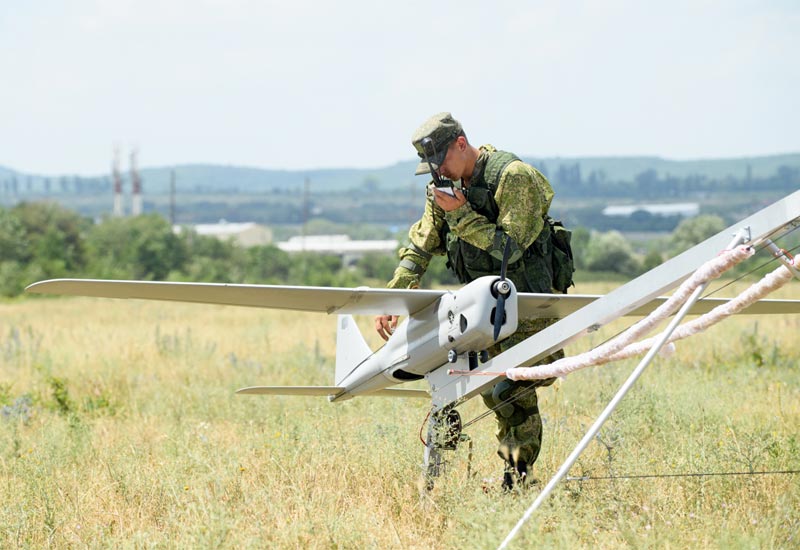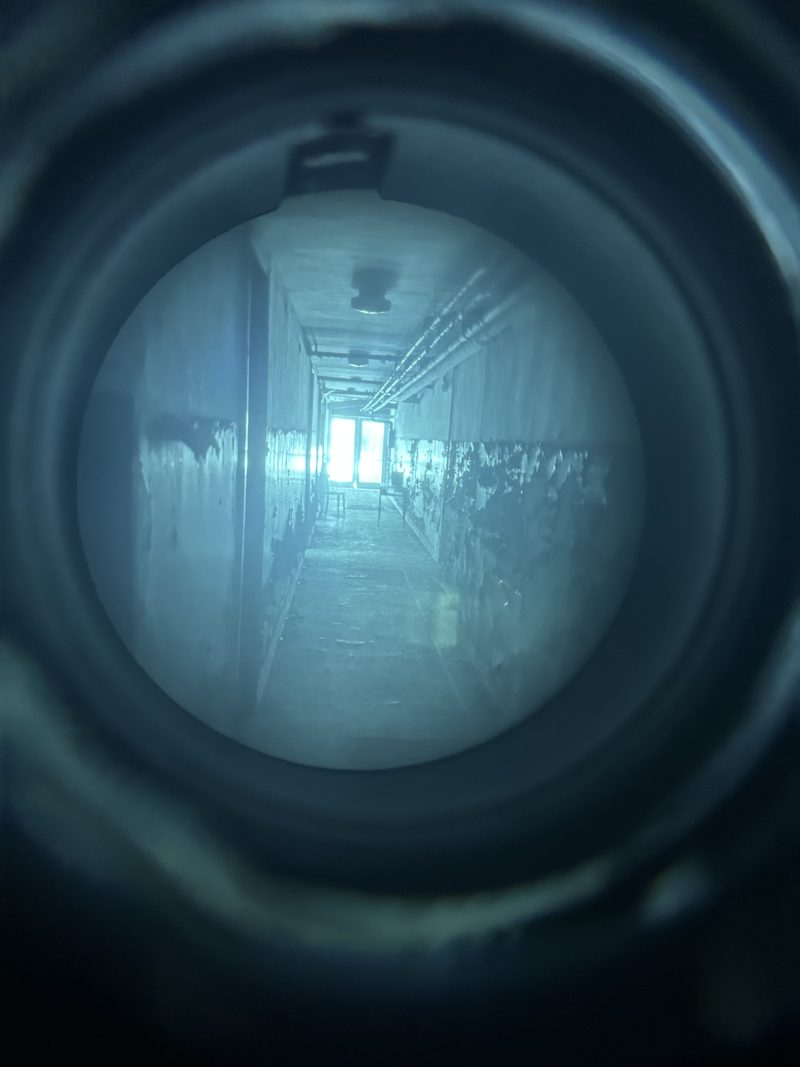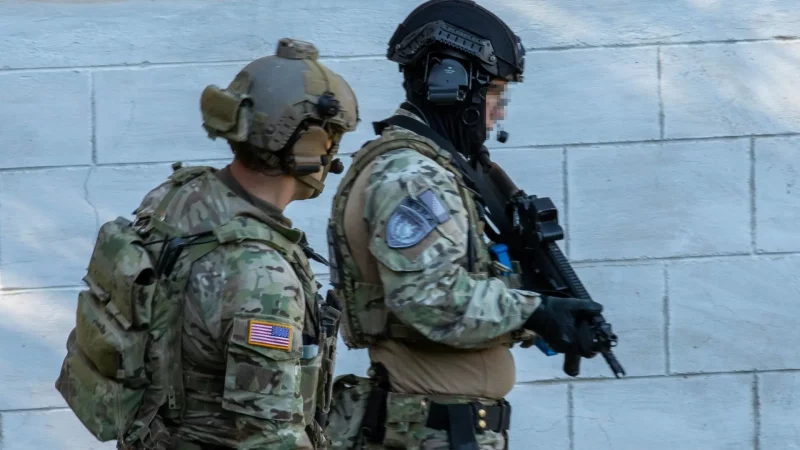The Orlan-10 is an unmanned aerial vehicle (UAV) developed by the Special Technology Center (STC) in Saint Petersburg for the Russian Armed Forces. It is a low-level (both in altitude and echelon) UAV that is comparatively cheap for such a class of drones. The price of this drone is reportedly between US$87,000 and US$120,000.
Introduction
Orlan-10 is a “take a look over that hill” drone, often up-marketed for export as some combined package of a spotter, EW, and C2 suite. His counterpart in the United States military drones is probably the Raven. It is usually used in groups of two or three. The first is used for reconnaissance at 1–1.5 km height, the second for electronic warfare, and the third as a transponder that transmits information to the control center.
As mentioned above, the Orlan-10 is used in groups, and one system can include up to 5 units. So far, more than 1000 Orlan-10s have been produced in 11 different variations for different use. In 2021, over 50 Orlan-10s were delivered for export 2021. It has been used in combat in Ukraine, Syria, Libya, and Nagorno-Karabakh.
Design
Orlan-10 was developed by the Russian radio technology company Special Technological Center (ООО Специальный Технологический Центр). This company takes part in the Russian development effort for the unified tactical command and control system within network-centric warfare. However, as it turned out during the study of a downed Russian UAV, only the body of the drone and the MNP-M7 navigation receiver was manufactured in Russia.
And even the receiver is based on the ADSP-BF534 chip produced by the American company Analog Devices. Other components: GPS tracker, starter generator, engine, ignition module, flight controller, telemetry transmission module, and GPS module were produced in the USA, Germany, Japan, China, and other countries. These components are dual-use goods that Russia purchases to apply for military purposes.

The Orlan-10 complex consists of unmanned aerial vehicles, launch and recovery systems, ground control segments, and swappable payloads. The UAV features a modular design with a high-wing configuration, while its tail section comprises a tailplane and a vertical stabilizer. Its wing span is 3.1m, and its aerodynamic fuselage is 2m long. The UAV’s empty and maximum take-off weights are 12.5kg and 16.5kg, respectively.
The Orlan-10 features a composite hull that reduces its radar signature. The drone is launched using a collapsible catapult and parachute recovery as a landing system.
Payloads
The Orlan-10s modular design is provided with several interchangeable payloads allowing for greater mission flexibility. It carries a day-light camera, a thermal imaging camera, a video camera, and a radio transmitter in a gyro-stabilized camera pod fitted under the fuselage. The cameras provide real-time intelligence, 3D maps, surveillance, and aerial reconnaissance of ground-based targets.
The payloads’ imagery, video, and other sensor data are transmitted to the ground control station in real time through a data link using 3G/4G cellular networks. The Orlan-10 is fitted with electronic warfare capability and can differentiate between friendly and enemy means of transmitting information. It can mount interference transmitters and set up zones for cellular jamming.
Command and control modes
The Orlan-10 can execute missions in both autonomous and remote control modes. An autopilot aboard the drone enables it to operate autonomously based on pre-defined waypoints. In this mode, the flight path can be modified by the operator during the flight. The drone can be remotely operated by its associated ground control station, installed on the MP32M1 command and control vehicle. Developed by Russian state-owned Roselectronika, the ground segment can control up to four aerial vehicles simultaneously.
In the remote control mode, an operator at the mobile ground segment sends command and control data to the drone through the digital data link. The combat training for this drone is not so complex.
Operational history
It has seen action in Ukraine, Syria, Libya, and Nagorno-Karabakh.
Ukraine
The Orlan-10 is reportedly being used in the War in Donbas. In this conflict, aerial reconnaissance by unmanned aerial vehicles is banned by the Minsk agreements, in which neither Russia nor Germany are parties. Ukrainian officials have claimed to have shot down or captured several UAVs of this type since 2014. Many media reports and social media accounts have reportedly shown downed UAVs of this type.
Since February 24, 2022, and the beginning of the Ukraine War, a dozen Orlan-10 used by the Russian Army were reportedly shot down by Ukrainian forces over Ukrainian territory. It is used alongside Gerlan-2 (Shahed 136) kamikaze drones.
Syria
The Orlan-10 is actively used by the Russian Ground Forces in the Syrian Civil War for reconnaissance, collecting aerial imagery, or 3D mapping in support of humanitarian convoys and S&R operations.
In November 2015, an Orlan-10 located the surviving member of a downed Russian Su-24M2 bomber and facilitated his speedy recovery. On March 10, 2020, the Orlan-10 drone was shot down by Syrian rebels in Suluk, Raqqa Governorate.

Belarus
In early February 2022, an Orlan-10 drone crashed near Brest.
Nagorno-Karabakh
The Armed forces of Kazakhstan shot down Orlan-10 during this conflict.
Technical specifications
The Orlan-10 is powered by an internal combustion engine, driving a two-blade propeller mounted in the nose. The drone can transmit telemetry data between 120km and 600km from the launch station and endure for approximately 18 hours. Its cruising and maximum speeds are 110km/h and 150km/h, respectively.
The UAV can fly at a maximum altitude of 5km in all weather conditions under challenging terrains. It can withstand wind speeds of 10m/s and operate in temperatures ranging from -30°C to 40°C.
In 2020, an updated variant of the Orlan-10 tactical UAV entered service with Russia’s ground forces. The updated variant is equipped with a laser designator to pinpoint targets for precision-guided artillery and aircraft munitions.
| Country of origin: | Russian Federation |
| Manufacturer: | Special Technology Center (STC) |
| Role: | Reconnaissance unmanned aerial vehicle |
| Status: | In-service since 2010 (Russian Ground Forces) |
| Take-off weight: | 15 kg |
| Payload weight: | 6 kg |
| Engine: | internal combustion engine (fuel – gasoline A-95) |
| Launch method: | folding catapult |
| Landing method: | via parachute recovery |
| Airspeed: | 90-150 km/h |
| Max. flight duration: | 16 hours |
| Max. complex range of applications: | up to 140 km from the ground control station (up to 600 km off-line) |
| Max. altitude above sea level: | 5,000 m |
| Max. wind speed at the start: | 10 m/s |
| Operating temperature range near the ground: | from −30 to +40 °C |







